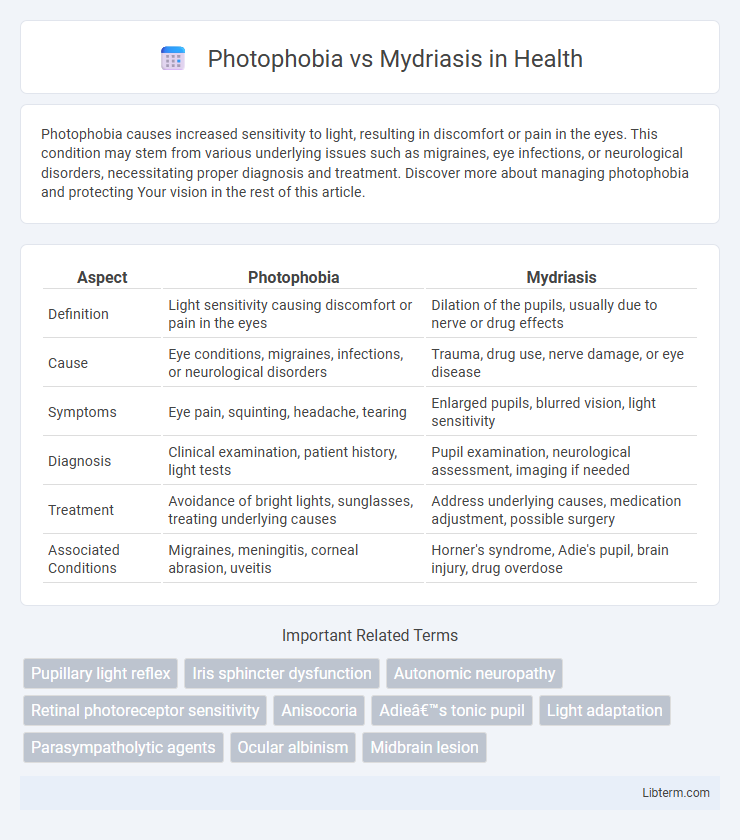Photophobia causes increased sensitivity to light, resulting in discomfort or pain in the eyes. This condition may stem from various underlying issues such as migraines, eye infections, or neurological disorders, necessitating proper diagnosis and treatment. Discover more about managing photophobia and protecting Your vision in the rest of this article.
Table of Comparison
| Aspect | Photophobia | Mydriasis |
|---|---|---|
| Definition | Light sensitivity causing discomfort or pain in the eyes | Dilation of the pupils, usually due to nerve or drug effects |
| Cause | Eye conditions, migraines, infections, or neurological disorders | Trauma, drug use, nerve damage, or eye disease |
| Symptoms | Eye pain, squinting, headache, tearing | Enlarged pupils, blurred vision, light sensitivity |
| Diagnosis | Clinical examination, patient history, light tests | Pupil examination, neurological assessment, imaging if needed |
| Treatment | Avoidance of bright lights, sunglasses, treating underlying causes | Address underlying causes, medication adjustment, possible surgery |
| Associated Conditions | Migraines, meningitis, corneal abrasion, uveitis | Horner's syndrome, Adie's pupil, brain injury, drug overdose |
Understanding Photophobia: Definition and Causes
Photophobia is an abnormal sensitivity to light causing discomfort or pain in the eyes, often linked to conditions like migraine, meningitis, or corneal abrasion. Unlike mydriasis, which is the dilation of the pupil typically caused by drugs or neurological issues, photophobia results from the eye's heightened response to normal light levels. Understanding causes of photophobia helps differentiate it from mydriasis, guiding appropriate diagnosis and treatment strategies.
What is Mydriasis? Key Concepts Explained
Mydriasis is the medical term for abnormal dilation of the pupil, often caused by trauma, neurological disorders, or certain medications such as anticholinergics and sympathomimetics. Unlike photophobia, which is sensitivity or discomfort in response to light, mydriasis involves the irregular enlargement of the pupil making the eye less responsive to bright light. Understanding the mechanisms behind mydriasis is crucial for diagnosing underlying conditions affecting the autonomic nervous system or ocular health.
Photophobia vs Mydriasis: Core Differences
Photophobia is an extreme sensitivity to light causing discomfort or pain in the eyes, while mydriasis refers to the abnormal dilation of the pupil, often resulting from medications, trauma, or neurological conditions. Photophobia primarily affects light tolerance and may accompany conditions like migraines or meningitis, whereas mydriasis directly impacts pupil size and can impair vision by allowing excessive light into the eye. The core difference lies in photophobia being a symptom related to increased light sensitivity versus mydriasis as a physical sign involving pupil dilation.
Common Symptoms of Photophobia
Photophobia is characterized by an abnormal sensitivity to light causing discomfort and eye pain, often accompanied by squinting, tearing, and headache. Mydriasis refers to abnormal dilation of the pupil, which can worsen light sensitivity but itself is not a symptom. Common symptoms of photophobia include excessive tearing, eye redness, and difficulty keeping the eyes open in bright environments.
Clinical Presentation of Mydriasis
Mydriasis presents clinically with an abnormally large pupil size that fails to constrict properly in response to light, often resulting in difficulty focusing and sensitivity to bright environments. Patients may report blurred vision and eye discomfort due to increased light exposure on the retina. Unlike photophobia, which is a subjective sensation of light sensitivity, mydriasis can be objectively observed through pupil examination and is often associated with underlying neurological or pharmacological causes.
Underlying Conditions Linked to Photophobia
Photophobia is commonly associated with underlying conditions such as migraine, meningitis, uveitis, and corneal abrasions, which cause increased light sensitivity due to inflammation or neural irritation. Mydriasis, the abnormal dilation of the pupil, can exacerbate photophobia by allowing excessive light to enter the eye, often linked to trauma, drug effects, or neurological disorders. Understanding these connections aids in diagnosing the root causes of photophobia and determining appropriate treatment strategies.
Major Causes of Mydriasis
Mydriasis, the dilation of the pupil, is primarily caused by factors such as drug use (including anticholinergics, sympathomimetics, and recreational substances like cocaine), neurological disorders (such as third cranial nerve palsy or Adie's tonic pupil), and trauma to the eye or brain. Unlike photophobia, which is a hypersensitivity to light often linked to inflammation or migraines, mydriasis results from impaired parasympathetic innervation or heightened sympathetic stimulation affecting the iris dilator muscle. Recognizing major causes like pharmacologic agents and nerve damage is crucial for differentiating mydriasis from photophobia and guiding appropriate clinical management.
Diagnostic Approaches for Photophobia and Mydriasis
Diagnostic approaches for photophobia involve detailed patient history, including onset, light sensitivity, and associated neurological symptoms, alongside slit-lamp examination to assess anterior segment abnormalities. Mydriasis diagnosis requires pupillary light reflex testing and pharmacological pupil dilation assessment to distinguish between physiological causes and pathological conditions such as third nerve palsy or Adie's tonic pupil. Neuroimaging may be employed to identify intracranial lesions when either condition presents with alarming neurological signs.
Treatment Strategies: Managing Photophobia and Mydriasis
Treatment strategies for photophobia focus on reducing light sensitivity through tinted lenses or sunglasses, addressing underlying causes such as migraines or eye inflammation, and using lubricating eye drops for dryness. Managing mydriasis involves treating the root cause, such as nerve damage or medication side effects, with possible use of miotic agents like pilocarpine to constrict the pupil. Both conditions may require specialist intervention to prevent complications and improve patient comfort and vision quality.
Prevention and Patient Education
Photophobia prevention involves minimizing exposure to bright lights by wearing UV-protective sunglasses and using tinted lenses or hats with brims to reduce glare. Educating patients about avoiding triggers such as prolonged screen time, stress, and certain medications helps manage symptoms effectively. For mydriasis, patients should be informed about the risks of prolonged pupil dilation, including light sensitivity, and advised to use protective eyewear and seek prompt medical evaluation if vision changes or discomfort occur.
Photophobia Infographic

 libterm.com
libterm.com